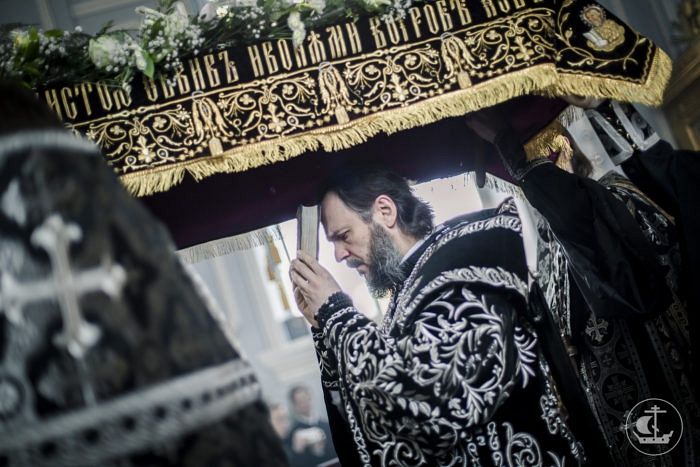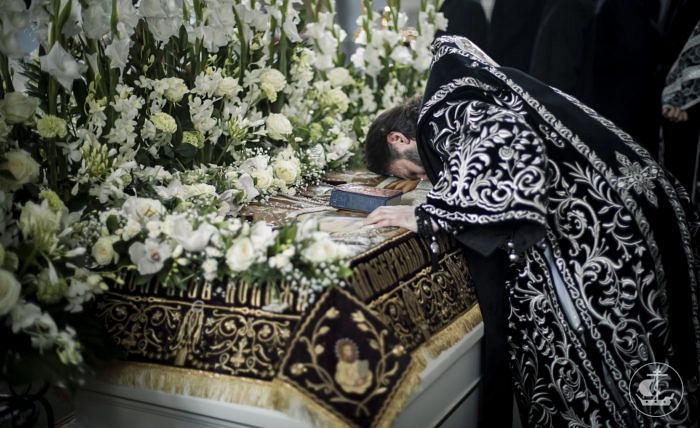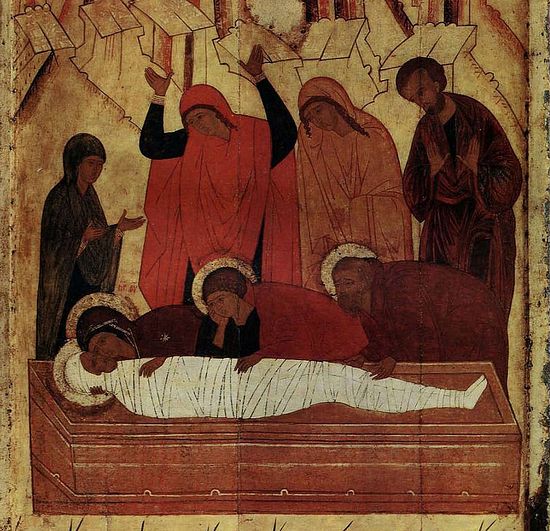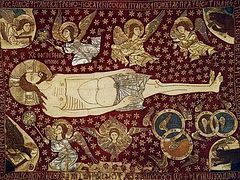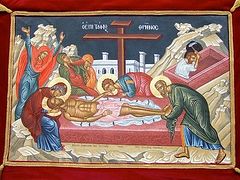What is the “Taking Out of the Holy Burial Shroud”?
The term Burial Shroud (in Russian, Plashchanitsa, in Greek, Epitaphios) first appeared in Russian liturgical books in the late sixteenth century. The Holy Burial Shroud is an icon that depicts the Savior lying in the tomb. It is usually a large piece of cloth with an image of the Savior laid in the tomb painted or embroidered on it. The Taking Out and Burial Service of the Holy Shroud are the two most important services on Great Friday of Holy Week. Great Friday (also called Holy Friday or Passion Friday) is the most sorrowful day in the Church’s liturgical year for all Christians worldwide. On this day we commemorate the Passion of Jesus Christ on the cross and His death.
The Holy Shroud is taken out of the altar on Friday afternoon during the Vespers of Great Saturday, at the third hour of Holy Friday—that is, the hour of the death of Jesus Christ on the cross (the service usually begins at about two o’clock in the afternoon). The Holy Shroud is carried out of the altar and placed in the middle of the church into the tomb. This is a raised platform adorned with flowers and perfumed as a symbol of our sorrow at the death of Christ. The Gospel is laid in the center of the Shroud. As the Shroud is carried out, the hymn “Noble Joseph is sung:
The noble Joseph,
when he had taken down Thy most pure body from the Tree,
wrapped it in fine linen and anointed it with spices,
and placed it in a new tomb.
Holy Friday Service, Vespers of Great Saturday. St. Mary’s Church (OCA), Minneapolis.
Liturgical details of the Burial Service of the Holy Shroud
The Matins of Great Saturday with the Burial Service of the Holy Shroud are usually celebrated on Friday evening. At this service the Holy Shroud occupies the place in church that is otherwise occupied by the icon of a feast.
Holy Saturday Lamentations, third stasis, Byzantine chant in English. Video by English Orthodox Chants.
The Matins begins as a funeral service. The funeral troparia are sung and the church is censed. Following the singing of Psalm 118 and the Evlogitaria,1 the church is lit and the news of the Myrrh-Bearing Women at the tomb is proclaimed. These are the first good tidings of the Resurrection of Christ, though it is proclaimed quietly as the Savior is still in the tomb.
During the service the faithful walk in procession, carrying the Holy Shroud around the church and singing the Trisagion hymn. This burial procession is accompanied by the funeral knell.
After the Burial Service, the Holy Shroud is carried up to the Royal Doors and then placed back in the middle of the church so that all the clergy and parishioners can venerate it. The Shroud remains there until late evening on Great Saturday.
It is only before the Paschal Matins, during the Midnight Service, that the Shroud is taken inside the sanctuary and laid on the altar where it will lie until the leave-taking of Pascha.
The iconography of the Holy Shroud
The Holy Shroud is a cloth depicting the Savior lying in the tomb. This Icon (and the Shroud is regarded as an icon) has its own iconographic traditions.
The central scene on the Holy Shroud depicts the “Deposition of Christ in the Tomb”, either completely or only showing the body of the buried Christ.
The icon, “The Deposition in the Tomb”, represents the scene of the burial of the crucified Savior as related in the Gospels. His body was taken down from the cross and wrapped in the Shroud—that is, the linen cloths with the spices. Next Christ was laid in the tomb, cut out of the rock, and a large stone was rolled in front of the entrance to the tomb.
There are various techniques for making the Shroud. In most cases a velvet canvas is taken as the base. For example, in the fifteenth to seventeenth centuries a facial stitching technique was applied to make Shrouds. In the eighteenth and nineteenth centuries, the masters combined gold embroidery (using gold threads) or relief application on cloth with painting. The face and body of Christ were depicted in painting.
In modern churches you often see machine-made Shrouds. These are the products of mass replication, as hand-made work is very expensive today.
The text of the Troparion of Great Saturday is usually embroidered or painted along the perimeter of the Shroud: “The Noble Joseph, when he had taken down Thy most pure Body from the tree, wrapped it in fine linen and anointed it with spices, and placed it in a new tomb.”
Traditions of the Procession of the Holy Shroud
In some churches the clergy carrying the Holy Shroud stop at the entrance of the church after the procession and lift the Shroud up high. Then the parishioners who are walking behind enter the church under the Shroud one after another. A small liturgical veil is normally placed in the center of the Shroud along with a book of the Gospels. Sometimes this veil is used to cover the face of Christ depicted on the Shroud, just as the face of a deceased priest lying in a coffin is covered with a sacramental veil, the aer, in accordance with the order for the burial of a priest. (The aer is a large rectangular veil that symbolically depicts the Shroud in which Christ was wrapped).

